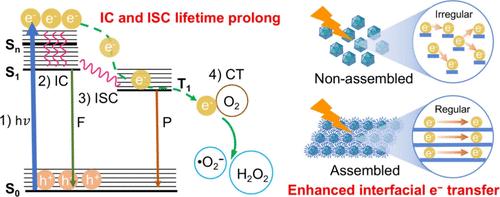Peptide-Guided Metal–Organic Frameworks Spatial Assembly Sustain Long-Lived Charge-Separated State to Improve Photocatalytic Performance
IF 15.8
1区 材料科学
Q1 CHEMISTRY, MULTIDISCIPLINARY
引用次数: 0
Abstract
The controlled fabrication of spatial architectures using metal–organic framework (MOF)-based particles offers opportunities for enhancing photocatalytic performances. The understanding of the contribution of assembly to a precise photocatalytic mechanism, particularly from the perspective of charge separation and extraction dynamics, still poses challenges. The present report presents a facile approach for the spatial assembly of zinc imidazolate MOF (ZIF-8), guided by β-turn peptides (SAZH). We investigated the dynamics of photoinduced carriers using transient absorption spectroscopy. The presence of a long-lived internal charge-separated state in SAZH confirms its role as an intersystem crossing state. The formation of an assembly interface facilitates efficient electron transfer from SAZH to O2, resulting in approximately 2.6 and 2 times higher concentrations of superoxide (·O2–) and hydrogen peroxide (H2O2), respectively, compared to those achieved with ZIF-8. The medical dressing fabricated from SAZH demonstrated exceptional biocompatibility and exhibited an outstanding performance in promoting wound restoration. It rapidly achieved hemostasis during the bleeding phase, followed by a nearly 100% photocatalytic killing efficiency against the infected site during the subsequent inflammatory phase. Our findings reveal a pivotal dynamic mechanism underlying the photocatalytic activity of control-assembled ZIF-8, providing valuable guidelines for the design of highly efficient MOF photocatalysts.

多肽引导的金属有机框架空间组装可维持长效电荷分离态以提高光催化性能
利用基于金属有机框架(MOF)的颗粒可控地制造空间结构为提高光催化性能提供了机会。如何理解组装对精确光催化机制的贡献,特别是从电荷分离和萃取动力学的角度,仍然是一个挑战。本报告介绍了一种在β-转肽(SAZH)引导下组装咪唑锌MOF(ZIF-8)的简便方法。我们利用瞬态吸收光谱研究了光诱导载流子的动力学。SAZH 中存在一个长寿命的内部电荷分离态,这证实了它作为系统间交叉态的作用。组装界面的形成促进了电子从 SAZH 向 O2 的高效转移,使超氧化物(-O2-)和过氧化氢(H2O2)的浓度分别比 ZIF-8 高出约 2.6 倍和 2 倍。用 SAZH 制成的医用敷料具有优异的生物相容性,在促进伤口愈合方面表现出色。在出血阶段,它能迅速止血;在随后的炎症阶段,它对感染部位的光催化杀灭效率接近 100%。我们的研究结果揭示了控制组装的 ZIF-8 光催化活性的关键动态机制,为设计高效的 MOF 光催化剂提供了宝贵的指导。
本文章由计算机程序翻译,如有差异,请以英文原文为准。
求助全文
约1分钟内获得全文
求助全文
来源期刊

ACS Nano
工程技术-材料科学:综合
CiteScore
26.00
自引率
4.10%
发文量
1627
审稿时长
1.7 months
期刊介绍:
ACS Nano, published monthly, serves as an international forum for comprehensive articles on nanoscience and nanotechnology research at the intersections of chemistry, biology, materials science, physics, and engineering. The journal fosters communication among scientists in these communities, facilitating collaboration, new research opportunities, and advancements through discoveries. ACS Nano covers synthesis, assembly, characterization, theory, and simulation of nanostructures, nanobiotechnology, nanofabrication, methods and tools for nanoscience and nanotechnology, and self- and directed-assembly. Alongside original research articles, it offers thorough reviews, perspectives on cutting-edge research, and discussions envisioning the future of nanoscience and nanotechnology.
 求助内容:
求助内容: 应助结果提醒方式:
应助结果提醒方式:


